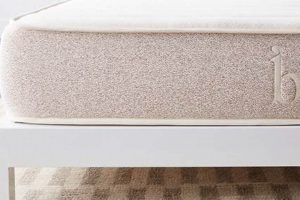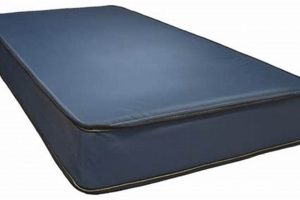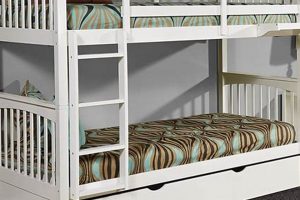This type of sleep surface is designed to regulate temperature, specifically addressing the common issue of overheating during sleep. These mattresses incorporate various technologies and materials aimed at dissipating heat and promoting airflow, leading to a more comfortable and restful sleep experience. One characteristic example features layers of gel-infused memory foam and breathable fabrics that work together to draw heat away from the body.
Temperature regulation during sleep is critical for maintaining optimal sleep quality. Overheating can disrupt sleep cycles, leading to restlessness and reduced overall sleep efficiency. These mattresses offer a potential solution by mitigating heat build-up, thus promoting a cooler and more consistent sleep environment. The advent of these technologies has provided an avenue for enhanced comfort for individuals who are prone to night sweats or live in warmer climates, marking a notable advancement in sleep technology.
The following sections will delve deeper into the specific technologies employed in cooling mattresses, the target demographic, and how to properly evaluate the features of different models to determine the most suitable option for individual needs.
Tips for Selecting a Temperature-Regulating Mattress
Selecting a mattress designed to regulate temperature requires careful consideration of individual needs and available technologies. The following guidelines offer practical advice to aid in making an informed decision.
Tip 1: Research Cooling Technologies: Familiarize yourself with the range of cooling technologies available. Gel-infused memory foam, open-cell foam structures, and phase-change materials all offer different mechanisms for heat dissipation. Understand the benefits and limitations of each to determine which aligns best with individual preferences.
Tip 2: Evaluate Material Breathability: Assess the breathability of the mattress cover and internal layers. Natural fibers such as cotton or bamboo tend to offer superior airflow compared to synthetic materials. Look for mattresses that explicitly advertise enhanced breathability in their construction.
Tip 3: Consider Mattress Firmness: Understand how firmness levels interact with temperature regulation. Firmer mattresses often allow for better airflow compared to softer models that contour more closely to the body. However, firmness preferences should also be considered to ensure adequate support and comfort.
Tip 4: Review Independent Testing and Certifications: Seek out independent testing data and certifications regarding the mattress’s thermal performance. Certifications such as CertiPUR-US indicate that the foam has been tested for emissions and durability, offering an added layer of assurance.
Tip 5: Account for Sleep Environment: Consider the ambient temperature of the sleep environment. If the bedroom is consistently warm, a mattress with advanced cooling features will likely be more beneficial. Conversely, in cooler climates, less aggressive temperature regulation may suffice.
Tip 6: Pay Attention to Edge Support: A mattress with good edge support can improve airflow around the mattress. Look for reinforced edges, or coils placed around the edges of the mattress for optimal support.
Tip 7: Factor in Personal Preferences: Consider factors such as body weight, sleep position, and any pre-existing health conditions that may influence temperature sensitivity. These aspects can significantly impact the effectiveness of temperature-regulating features.
By carefully evaluating these factors, individuals can select a mattress that effectively regulates temperature, promoting a more comfortable and restorative sleep experience.
The subsequent sections will expand on specific mattress models and brands known for their temperature-regulating properties, providing further guidance for selecting the ideal sleep solution.
1. Temperature regulation
Temperature regulation is a fundamental aspect of sleep comfort, directly impacting the efficacy of a “twin cooling mattress”. The ability of a mattress to maintain a stable and comfortable sleep temperature is paramount to minimizing sleep disturbances and promoting restorative rest.
- Material Composition and Heat Transfer
The materials utilized in a mattress directly influence its thermal properties. High-density foams, for example, tend to trap heat, while open-cell structures and gel-infused materials are designed to facilitate heat dissipation. The specific composition of a “twin cooling mattress” dictates its capacity to draw heat away from the sleeper’s body and release it into the surrounding environment. A mattress incorporating phase-change materials can further regulate temperature by absorbing or releasing heat as needed to maintain a consistent surface temperature.
- Airflow and Ventilation
Effective airflow within a mattress is crucial for removing heat and moisture. Designs incorporating ventilation channels or breathable fabrics promote the circulation of air, preventing the build-up of heat and humidity. “Twin cooling mattress” often feature specialized layers or constructions that enhance airflow, such as perforated foam layers or covers made from moisture-wicking materials. Adequate ventilation minimizes the potential for overheating and creates a more comfortable sleep environment.
- Body Temperature Regulation
The human body naturally regulates its temperature during sleep, typically lowering its core temperature in preparation for rest. A mattress that inhibits this process can lead to discomfort and sleep disruption. “Twin cooling mattress” are designed to work in concert with the body’s natural temperature regulation mechanisms, facilitating heat transfer and maintaining a cooler sleep surface. This is particularly important for individuals prone to night sweats or who live in warmer climates, as it helps prevent overheating and promotes deeper, more restful sleep.
- Impact on Sleep Cycles
Optimal temperature regulation is essential for maintaining healthy sleep cycles. Overheating can disrupt sleep patterns, leading to frequent awakenings and reduced sleep quality. “Twin cooling mattress” aim to minimize these disruptions by providing a consistently comfortable sleep temperature. This, in turn, can improve sleep efficiency and promote longer periods of uninterrupted rest. By maintaining a stable sleep environment, these mattresses can contribute to improved cognitive function and overall well-being.
The effectiveness of a “twin cooling mattress” is inextricably linked to its capacity for temperature regulation. The careful selection of materials, attention to airflow, and compatibility with the body’s natural temperature regulation processes are crucial considerations in evaluating the performance of these sleep surfaces. A mattress that successfully manages temperature provides a tangible benefit to sleep quality and overall health.
2. Material Breathability
Material breathability is a critical determinant in the efficacy of a “twin cooling mattress.” This characteristic refers to the ability of the mattress materials to allow air to circulate freely, facilitating the removal of heat and moisture from the sleeping surface. The direct consequence of enhanced breathability is a reduction in the build-up of body heat, thereby creating a cooler and more comfortable sleep environment. The selection of materials with inherently high breathability is, therefore, a fundamental design principle of these specialized mattresses.
Examples of breathable materials commonly employed in “twin cooling mattress” construction include open-cell foams, natural fibers such as cotton and bamboo, and specialized synthetic fabrics engineered for moisture-wicking properties. Open-cell foam structures, unlike traditional memory foam, allow for greater airflow within the mattress core. Natural fibers exhibit inherent breathability due to their porous structure, promoting ventilation and reducing humidity. Moisture-wicking fabrics actively draw perspiration away from the body, enhancing evaporative cooling. Conversely, mattresses constructed primarily with closed-cell foams or synthetic materials lacking breathability tend to trap heat, negating the intended cooling effect. The practical significance of this understanding lies in the informed consumer’s ability to distinguish between mattresses that genuinely promote cooling and those that merely claim to do so. Understanding Material breathability can determine whether or not this mattress can keep moisture away from the body and help the user to have good sleep.
In summary, material breathability constitutes an indispensable component of a “twin cooling mattress.” Its influence on heat dissipation and moisture management is paramount to achieving the desired cooling effect. Challenges in assessing breathability often arise from marketing claims that lack scientific validation. Therefore, scrutiny of material specifications and independent testing data is essential for verifying the actual breathability and overall performance of a given “twin cooling mattress.”
3. Support System
The support system within a “twin cooling mattress” significantly influences its overall performance and longevity. The primary function of the support system, typically composed of innersprings, foam cores, or hybrid constructions, is to provide adequate spinal alignment and pressure relief. However, its design also indirectly impacts the mattress’s cooling capabilities. A well-designed support system prevents excessive sinking into the mattress, thereby maintaining airflow around the sleeper’s body. Conversely, a weak or poorly constructed support system can lead to increased body contact with the mattress surface, reducing airflow and hindering heat dissipation. For example, a mattress with a dense memory foam comfort layer combined with an inadequate innerspring system may conform too closely to the body, trapping heat despite the presence of cooling technologies in the upper layers.
The type of support system also plays a role in temperature regulation. Innerspring systems, particularly those with individually wrapped coils, allow for greater airflow compared to solid foam cores. Hybrid mattresses, which combine innersprings with layers of foam, aim to strike a balance between support, comfort, and breathability. The practical implication is that individuals seeking optimal cooling performance should carefully consider the type and construction of the support system. Mattresses with enhanced edge support, often achieved through reinforced coils or foam encasement, can further improve airflow around the perimeter of the mattress, contributing to a cooler sleep experience. A practical example could be a coil mattress, which is combined with cooling gel infused memory foam, which provides the best of both worlds. Adequate support and cooling effect.
In summary, the support system is not merely a structural component of a “twin cooling mattress,” but an integral factor in its ability to regulate temperature effectively. The design and materials used in the support system influence airflow, pressure relief, and spinal alignment, all of which contribute to a cooler and more comfortable sleep environment. The challenge lies in identifying mattresses where the support system is thoughtfully integrated with the cooling technologies to maximize their combined benefits.
4. Size considerations
The dimensions of a “twin cooling mattress” directly correlate with its capacity to regulate temperature effectively. The surface area of the mattress influences heat retention and dissipation, impacting overall sleep comfort.
- Surface Area and Heat Dissipation
Larger mattresses possess a greater surface area, potentially leading to increased heat retention, especially if the cooling technologies are not proportionately scaled. Conversely, smaller mattresses, such as the “twin cooling mattress,” have a reduced surface area, which may allow for more efficient heat dissipation if designed appropriately. The ratio of cooling material to surface area is a critical factor in determining the effectiveness of temperature regulation. For example, a queen-sized mattress with the same cooling technology as a twin may not feel as cool due to the increased surface area needing to be regulated.
- Sleeping Space and Proximity to Walls
The dimensions of the sleeping space, as well as the mattress’s proximity to walls, influence airflow and heat build-up. A “twin cooling mattress” positioned tightly against walls may experience reduced airflow around its perimeter, potentially compromising its cooling capabilities. The placement of the bed within the room and the presence of obstructions can impact ventilation and, consequently, the perceived coolness of the mattress. A twin mattress, in comparison to larger mattresses, may afford greater flexibility in positioning within the room to optimize airflow.
- Individual Sleeper Characteristics
Individual factors, such as body size and sleeping position, interact with the mattress size to influence heat distribution. A larger individual sleeping on a “twin cooling mattress” may experience concentrated pressure points, leading to localized heat build-up. Smaller individuals or those who change positions frequently may benefit more from the reduced surface area of a twin mattress, allowing for more effective cooling across the entire sleep surface. The density of the sleeper, combined with sleeping habits, influences the effectiveness of the mattress’s cooling mechanisms.
- Material Distribution and Layering
The distribution of cooling materials within the mattress layers must be optimized for the specific dimensions of the “twin cooling mattress”. Even distribution of cooling gel or phase-change materials is essential to ensure consistent temperature regulation across the entire surface. Uneven distribution or layering of materials can lead to hot spots or inconsistent cooling performance. Manufacturers must carefully calibrate the design to account for the reduced surface area and ensure uniform cooling benefits. For instance, a twin sized mattress might
need more strategic layer placement in key body zones for effective temperature regulation.
The relationship between size considerations and the efficacy of a “twin cooling mattress” is complex and multifaceted. The dimensions of the mattress interact with sleeping space, individual characteristics, and material distribution to influence temperature regulation. Optimal cooling performance requires careful consideration of these factors and a design that is specifically tailored to the size of the mattress and the needs of the sleeper. Larger mattresses needs to dissipate more heat compared to twin cooling mattress.
5. Heat Dissipation
Heat dissipation constitutes a core function of a “twin cooling mattress,” influencing the overall sleeping experience. Effective heat removal from the sleep surface directly correlates with thermal comfort and reduced sleep disturbances. This discussion will delineate key facets of heat dissipation in the context of these mattresses.
- Material Conductivity
The thermal conductivity of mattress materials is a primary determinant of heat dissipation. Materials with high thermal conductivity, such as copper-infused foams or phase-change materials, facilitate the transfer of heat away from the body. In a “twin cooling mattress,” these materials are strategically incorporated to enhance heat removal. The selection of thermally conductive materials over insulating ones is crucial for promoting a cooler sleep environment. Failure to utilize materials with high conductivity can negate other cooling features. For example, using regular memory foam may be counterproductive.
- Airflow Dynamics
Airflow within the mattress structure is essential for convective heat transfer. Open-cell foam structures, ventilation channels, and breathable fabrics promote air circulation, facilitating the removal of heat and moisture. A “twin cooling mattress” designed with enhanced airflow channels allows for greater heat dissipation compared to a mattress with a dense, non-ventilated core. The dynamics of airflow influence the rate at which heat is removed from the sleep surface. A design lacking adequate airflow restricts heat movement.
- Evaporative Cooling
The evaporation of moisture from the sleep surface contributes to cooling. Fabrics with moisture-wicking properties draw perspiration away from the body, promoting evaporative cooling. A “twin cooling mattress” often features covers made from these specialized fabrics to enhance heat dissipation. The effectiveness of evaporative cooling depends on humidity levels and the permeability of the mattress cover. The evaporative cooling factor alone can’t carry heat away. These two combined creates synergy for a cooler experience.
- Surface Temperature Gradient
The temperature difference between the body and the mattress surface drives heat transfer. A “twin cooling mattress” aims to maintain a lower surface temperature than the sleeper’s body, encouraging heat dissipation. The ability of the mattress to maintain a cooler surface temperature depends on the combined effects of conductive, convective, and evaporative cooling mechanisms. A larger temperature gradient facilitates more efficient heat removal.
The interplay of material conductivity, airflow dynamics, evaporative cooling, and surface temperature gradient defines the heat dissipation capacity of a “twin cooling mattress.” Optimal performance requires a synergistic combination of these factors, ensuring efficient and sustained heat removal from the sleep surface. For a twin cooling mattress, the most effective heat dissipation is to focus on all of the four factors, because it gives a compounding effect.
6. Moisture Wicking
Moisture wicking is an essential property of materials used in “twin cooling mattress” construction, directly influencing sleep comfort and hygiene. The process involves the ability of a fabric to draw moisture, typically perspiration, away from the body and towards the outer surface of the material, where it can evaporate. The effectiveness of moisture wicking significantly impacts the thermal environment of the sleeping surface. By removing perspiration, the fabric prevents the build-up of humidity, which can lead to discomfort, increased body temperature, and potential microbial growth. Consequently, the inclusion of moisture-wicking materials in a “twin cooling mattress” contributes to a cooler, drier, and more hygienic sleep environment.
Examples of moisture-wicking materials commonly incorporated into “twin cooling mattress” covers and internal layers include specialized synthetic fabrics, such as polyester blends with engineered cross-sections, and natural fibers like merino wool. These materials possess inherent capillary action, enabling them to efficiently transport moisture away from the skin. For instance, a “twin cooling mattress” with a cover made of a high-performance polyester knit will draw perspiration away from the body more effectively than a mattress with a traditional cotton cover. The practical significance of this lies in the ability of the mattress to maintain a comfortable sleep temperature, even in conditions where perspiration is elevated. This also reduces the likelihood of bacterial or fungal growth within the mattress, promoting a healthier sleep surface.
In summary, moisture wicking is a critical component of a “twin cooling mattress,” facilitating temperature regulation and enhancing sleep hygiene. The choice of materials with inherent moisture-wicking properties is paramount to achieving the desired cooling effect. While marketing claims may highlight moisture-wicking capabilities, it is essential to examine the specific fabric composition and construction to assess its actual effectiveness. A “twin cooling mattress” with a well-designed moisture-wicking system offers a tangible benefit to sleep quality and overall health.
Frequently Asked Questions
This section addresses common inquiries regarding the functionalities, benefits, and considerations associated with mattresses engineered to provide a cooling sleep surface.
Question 1: What specific mechanisms facilitate the cooling effect in a “twin cooling mattress?”
The cooling effect is primarily achieved through a combination of material selection and design. Open-cell foam structures, gel infusions, phase-change materials, and moisture-wicking fabrics all contribute to heat dissipation and temperature regulation. The specific blend and layering of these technologies determine the overall cooling performance.
Question 2: How does the size of a “twin cooling mattress” influence its cooling capabilities?
The surface area of the mattress impacts heat retention and dissipation. A smaller surface area, such as that of a twin mattress, may allow for more efficient cooling compared to larger sizes, provided the cooling technologies are appropriately scaled to the dimensions.
Question 3: Are there any potential drawbacks associated with using a “twin cooling mattress?”
Depending on the materials used, some cooling mattresses may exhibit a different feel compared to traditional mattresses. Individuals sensitive to certain materials may experience allergic reactions or skin irritation. Furthermore, the longevity of the cooling effect can vary depending on the quality and
durability of the materials used.
Question 4: How should one properly maintain a “twin cooling mattress” to preserve its cooling properties?
Regular cleaning and proper ventilation are essential. Avoid exposing the mattress to direct sunlight or excessive heat, as this can degrade the cooling materials. Using a breathable mattress protector can also help maintain hygiene without compromising airflow.
Question 5: Are “twin cooling mattress” suitable for all sleepers, regardless of their individual needs and preferences?
While these mattresses offer potential benefits for individuals who tend to overheat during sleep, they may not be ideal for those who prefer a warmer sleep environment. Personal preferences, body weight, and sleeping position should all be considered when evaluating the suitability of a cooling mattress.
Question 6: How does the support system of a “twin cooling mattress” contribute to its cooling performance?
The support system, whether composed of innersprings or foam, influences airflow and pressure distribution. A well-designed support system prevents excessive sinking into the mattress, promoting air circulation around the body and facilitating heat dissipation.
In summary, “twin cooling mattress” employ various technologies to regulate temperature and promote a cooler sleep environment. Careful consideration of individual needs and preferences, as well as proper maintenance, is essential to maximizing the benefits of these mattresses.
The subsequent section will provide comparative analyses of specific “twin cooling mattress” models available on the market.
Conclusion
The exploration of “twin cooling mattress” has revealed the multifaceted nature of sleep temperature regulation. Effective implementation of cooling technologies, breathable materials, and supportive designs are essential for creating a sleep surface that mitigates heat retention. The considerations of size, heat dissipation, and moisture wicking further underscore the complexity of engineering a truly effective sleep solution.
The advancement of sleep technology continues to offer potential avenues for improved rest. Continued research and development in the field of “twin cooling mattress” may yield even more refined solutions, potentially transforming the sleep experience for those seeking thermal comfort. Individuals should carefully evaluate their specific needs and preferences to discern the most suitable option from the array of available models.





![Best Walmart Twin Size Blow Up Mattress [Guide] Organic & Natural Mattress Buyer’s Guide: Non-Toxic Sleep Solutions Best Walmart Twin Size Blow Up Mattress [Guide] | Organic & Natural Mattress Buyer’s Guide: Non-Toxic Sleep Solutions](https://mattressworldpa.com/wp-content/uploads/2025/07/th-5075-300x200.jpg)

